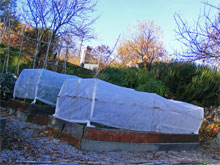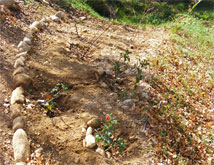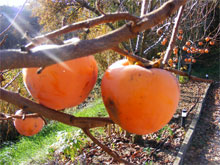
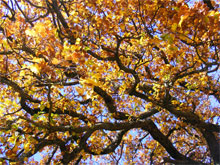
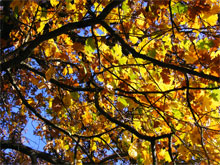
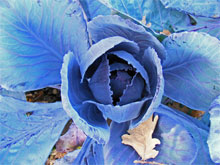
7 December 2011
It’s most definitely a mast year, at least for the smaller of the two large oaks – a Quercus pubescens (downy oak). The larger one is dropping a lot of acorns but nothing compared to the other which has been chucking them down with loud crashes and thuds for weeks, causing me to jump out of my skin frequently. There have been several near-misses as hurtling acorns went whizzing past my ears.
The shoulder situation has been worsened by considerable bed-building and rose-transplanting, as I plough on with my plan to make the area outside the living room window at the south end of the house look less like a wilderness and more like the kind of place you’d like to spend some time.
I had Manuela clear most of the bank leading down to the old vaschetta: it’s so wonderful having someone else to do the boring preparatory work. She removed thousands of stones, I carted away the little ones as filling for the pergola in the orchard, and now the larger stones are becoming an edging for the garden which will run up the slope. Do I like stone edging? Sometimes I look at it and think “oh no, Snow White and the Seven Dwarves!” Other times I’m fairly neutral. And stone is so much part and parcel of this stony stony ground. I’m only using the very largest ones I can find along there, so that it looks planned rather than poxy. We’ll see. And anyway, hopefully the plants will cover it all before long.
So far, into that bank have gone: one Cornus kousa Satomi, two Viburnum bodnantense Dawn and some transplanted roses.
I think a lot of rubbish is written and spoken about transplanting roses. At least, I hope so. Either I have always been lucky, or roses and I have something special going on, or else it really isn’t as high-risk a business as people like to make out. I don’t know how many roses I’ve hauled up, hacked about and stuck into undignified holes over the years, and (touch wood) I’ve never lost a single one. I’ve never given any thought to the season or the state of the plant. Oh, sometimes they look a bit miserable for a while. But eventually they perk up. I really don’t see the problem.
But in the interests of science, I’m planning a little experiment on my new bank. First of all, it should be said that the roses should definitely be much happier in their new home: where they have been up to now, on the bank by the back door, they are in sandy ground which freezes pretty solid and gets more or less no sunshine for about four months of the year – very north-facing indeed. What on earth possessed me to put them there, heaven knows. But they have struggled on bravely for the past six or seven years, valiantly producing their wine-red blooms (these are R. guizzo rosso, by Rose Barni, my favourite Italian rose producer/vendor) through the spring and intermittently through the summer, before falling prey to every disease known to man because they are so exhausted from their uneven struggle.
Now they’re going into a lovely sunny south-east facing bank, beautifully protected from the wind, into great big purpose-made holes full of delicious compost. I have studiously avoided, this time, adding fertilizer at this point – about the only instruction that most rose pundits agree on, saying that you need to give the roots time to settle in before encouraging too much leaf growth. I trimmed the plants here and there but not too much; I prepared the new holes, hauled the plants out of their old spot and got them straight back into the ground before the roots had time to feel exposed to the air; and I soaked them and soaked them and will continue to do so for days to come.
The experiment? Well, of the nine roses I plan to move, I have uprooted three now. They still have foliage. In fact, they seem to be producing a whole new crop of it and some have buds too – ie by no means are they dormant. I shall wait another few weeks, hopefully until they are dormant, maybe some time just before New Year, and move the second batch; then I’ll wait till early February to move the final ones. Just to see, once and for all, whether season has much effect. And of course I’ll then keep my fingers crossed and hope that my good rose luck holds out as ever. For the sake of my brave roses, I do hope so.
What else will go in there? I have taken many cuttings from the Abelia grandiflora plants along the edge of that raised platform in built along there earlier in the year. They’re in the remarkbly ugly, tacky, super-cheap greenhouse which I have screwed to the sunny wall of the house right outside my office window, along with L’s experiments in winter basil and coriander and various other tempting-fate-style propagating experiments. I keep saying I’m going to replace the thin, badly ripped plastic cover (the whole thing – empty at the time, thank goodness – blew off down the bank one windy night before I had found time to anchor it properly) with something more sturdy and attractive. But I bet I won’t. That’s a bit of path which we never walk along much at this time of year, so the greenhouse ends up being rather inconspicuous, despite being so aesthetically unpleasing… either that or I’m just exercising my usual ostrich technique for dealing with things I don’t want to see/deal with. And it’s working perfectly.
Digging those holes for my roses drove home just what a drought we’re going through. Up on the surface, nightly dews mean that there’s a vague appearance of healthy damp. Fifty, 60, 70 centimetres down, the ground gets harder and harder and drier and drier. We need several days of quietly persistant precipitation to rectify this situation. It’s getting quite desperate. The level of Lake Trasimeno is… well, if you believe the local press, it’s plummetting to all-time lows, though this chart doesn’t seem to show anything of the kind.
